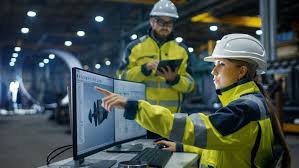Workplace safety is essential for every organization. It protects employees, boosts productivity, prevents accidents, and maintains a company’s reputation. Proactive safety measures are key to reducing risks early. This blog will cover how businesses can prevent hazards by identifying risks, implementing protocols, using technology, fostering a safety-first culture, and improving continuously. By the end, you’ll gain actionable tips for a safer, more efficient workplace.
Identifying Potential Hazards
The first step to preventing workplace hazards is understanding where risks exist. Every work environment is unique, so thoroughly assessing potential dangers is essential.
Conducting Risk Assessments
Risk assessments are the foundation of proactive safety measures. This process involves:
- Inspecting workspaces for common hazards such as cluttered walkways, malfunctioning equipment, or unsafe working conditions.
- Analyzing historical data on workplace incidents to spot recurring risks.
- Consulting employees, as they often have firsthand knowledge of issues that could be overlooked.
- Identifying long-term risks, such as exposure to hazardous materials or ergonomic strain from repetitive tasks.
For example, industries like construction may conduct job hazard analyses (JHAs) before projects begin. JHAs involve breaking down tasks step-by-step to pinpoint risks and implement solutions before employees even begin their work.
Being proactive at this stage can eliminate hazards before accidents occur, saving lives and costs down the line.
Implementing Safety Protocols
Even the most comprehensive risk assessment won’t be effective without robust safety protocols in place.
Training Employees
Proper training equips employees with the knowledge they need to work safely. Address areas such as:
- Equipment Use: Teach employees how to handle machinery and tools correctly.
- Emergency Preparedness: Train teams on fire safety, evacuation methods, and first-aid response.
- Situational Awareness: Encourage employees to report hazards and remain vigilant on the job.
Regular training sessions and refresher courses ensure safety practices remain ingrained in the workplace.
Providing the Right Equipment
Quality personal protective equipment (PPE), such as helmets, gloves, safety goggles, and hearing protection, can be life-saving. Additionally, invest in ergonomic equipment, such as adjustable chairs and desks, to reduce strains and injuries in office environments.
Establishing Procedures
Clear and detailed safety procedures help employees know what to do in various scenarios. Protocols might include:
- Safe handling information for chemicals.
- Procedures for operating heavy machinery.
- Steps to de-escalate potentially volatile situations.
Building Commissioning
Hiring building commissioning consultants is an often-overlooked yet invaluable step in workplace safety. These services ensure that buildings, systems, and equipment are functioning as intended. A fully commissioned building reduces risks such as faulty electrical systems, insufficient ventilation, or unstable structures, offering a safer environment for all.
When employees are trained and equipped, and facilities are optimized, the chances of an accident drastically decrease.
Utilizing Technology to Enhance Safety
Modern tools and software are revolutionizing workplace safety. Organizations that integrate technology into their safety measures often enjoy more efficient and effective hazard prevention.
Safety Software
Platforms like safety management software can digitize the entire safety process, making it easier to record incidents, track safety compliance, and organize training schedules.
Monitoring Systems
Technology can provide real-time monitoring to identify risks as they arise. Examples include:
- Wearable Sensors: Devices that monitor fatigue, detect harmful environments, or alert users to unsafe conditions.
- IoT-Based Solutions: Internet of Things (IoT) devices connect machinery, enabling predictive maintenance that prevents equipment breakdowns or malfunctions.
- CCTV and AI Analytics: Surveillance cameras combined with AI can help detect hazardous behavior automatically, such as a worker in a restricted zone without proper gear.
Technology enables businesses to make smarter safety decisions and respond quickly to potential dangers.
Encouraging Employee Involvement
Creating a safety culture is critical to workplace hazard prevention. Employees must feel empowered to contribute to safety initiatives and understand the role they play in maintaining a secure environment.
Leading by Example
Leaders should actively participate in safety measures and address safety issues brought up by employees. A positive example from management pushes safety culture company-wide.
Creating Anonymous Reporting Channels
Sometimes, employees may hesitate to report hazards or incidents for fear of judgment. Providing anonymous reporting tools encourages workers to highlight risks or concerns without consequences.
Recognizing Employee Contributions
Acknowledging employees who actively promote safety fosters a sense of involvement. Whether it’s highlighting them in a company newsletter, providing financial incentives, or giving verbal recognition, these small efforts go a long way.
When employees are involved, it creates a supportive environment where everyone actively works toward the shared goal of safety.
Continuous Improvement
Workplace safety isn’t a one-time effort; it requires ongoing evaluation and adaptation. Businesses that prioritize regular improvements to their safety protocols remain ahead of potential hazards.
Conducting Regular Audits
Schedule periodic safety audits to ensure compliance with policies and identify any gaps. These audits can involve:
- Reviewing training programs.
- Inspecting equipment for wear and tear.
- Measuring the effectiveness of current safety procedures.
Staying Updated on Regulations
Laws and safety regulations frequently change, particularly in industries like manufacturing or healthcare. Keeping up-to-date ensures your business stays compliant and avoids penalties.
Adapting to Feedback
Use feedback from employees, audits, and incident reports to refine safety measures. For example, if employees repeatedly identify a particular area as hazardous, implementing structural improvements or additional training may be necessary.
Continuous improvement ensures a safer workplace that adjusts to evolving industry needs and standards.
Conclusion
Preventing hazards through proactive workplace safety measures isn’t just good practice; it’s also a moral obligation to protect employees. By assessing risks, implementing comprehensive protocols, leveraging technology, involving employees, and striving for consistent improvement, businesses can create safe and thriving work environments.
